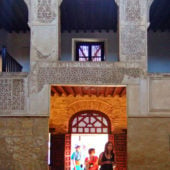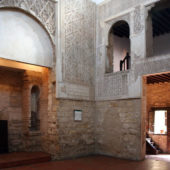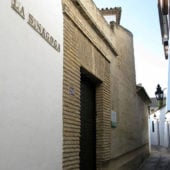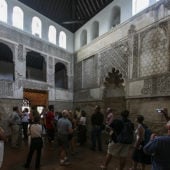Cordoba’s synagogue is the only preserved synagogue in the Andalusian area of Spain after the expulsion of the Jews in 1492.
The Jewish quarter is the most renown section of Cordoba’s historic area and is one of the largest in Europe. Rabbi Moses Maimonedes, the preeminent medieval Jewish scholar and first person to write a systematic code of Jewish law, was born and lived in this neighborhood. Along the city wall, northwest of the Mosque-Cathedral, the winding medieval streets have a Moorish influence, due to the Jewish community’s period of prosperity under the Caliphate of Cordoba.
Jews were in Cordoba as early as the second century. Under Moslem rule, Jews and Christians were allowed to worship freely and to be self-governing. During the 11th and 12th centuries, the Jewish community reached its pinnacle of prosperity, intellectually and financially, which also coincided with Cordoba’s greatest moment in history. Cordoba was Europe’s bright light in the middle of the Dark Ages, in terms of business, intellectual achievement and prosperity. Its mosque was on a par of the one in Damascus, and scholars would make the journey to study at the famed university and outstanding library. The city’s markets and palaces stunned visitors. Cordoba even had paved streets and street lighting.
However, the Caliphate fell in 1031, which had negative repercussions for the Jewish and Arab communities over the long term, including the Spanish Inquisition. Civil war devastated much of the prosperity, palaces, streets and homes. Religious tolerance ended. Some Jews fled to northern Spain or abroad. When Ferdinand III ruled Cordoba for a brief time, he re-established religious tolerance and the Jews were once again free to worship and self-govern as they pleased. In the 1340s, anti-Semitic Papals were jealous of the Jews’ prosperity and influence. In 1391, they attacked the Jewish neighborhood. In 1492 Ferdinand and Isabel offered the Jews conversion or exile, with the result of a mass exodus of Sephardic Jews.
In 1315, the Cordoba Synagogue was designed in the Mudéjar style by architect Isaac Mojeb. It is one of the three synagogues still in existence in Spain today. The other two are in Toledo. Construction began on September 20, 1314, and it was completed on September 1, 1315. The exterior of the façade is plain brick. Inside, Moorish-shaped arches and multi-bulbous arches are used for décor or in windows and doorways. Intricate mosaics and relief designs cover the stuccowork. They feature geometric patterns with four, six or eight-pointed stars; organic vegetal forms; and carved Hebrew inscription, primarily from the Psalms. There are two rooms downstairs, an entry atrium and a prayer-room. The Aron-Kodesh was situated against the east wall. The entry atrium also has a staircase to the upstairs women’s gallery, which overlooks the prayer-room. The surrounding buildings were most likely used as baths and a Talmudic school.
Interestingly, the Mudejar reliefs were covered, and in 1492 the synagogue became the home of the St. Quiteria hermitage. It was subsequently a hospital for hydrophobic people, and in 1588 it became the property of the shoemakers’ guild and was used as a Catholic chapel, under the patronage of St. Crispin and St. Crispiano. In the 19th century the Synagogue became a nursery school. It was then that the paneling was replaced with a barrel vault and plasterwork, since its old roof was falling to pieces. Don Mariano Parraga, a priest, discovered the plasterwork on the walls in 1884, when part of the mortared walls of the synagogue collapsed. One year later, in 1885, the Synagogue was declared a national monument and its restoration was started.
Cordoba Synagogue has undergone several phases of restoration: in 1885, after the building had been declared a national monument, by Felix Hernandez in 1929, another in 1977 to re-open the building, and lastly in 1985 to celebrate the 850th birthday of Maimonides.
Cordoba Synagogue has recently been used for services, but it is regularly open for visitors as a museum. It remains a testimony to the brilliance, traditions and culture of the Cordoba Jews.




